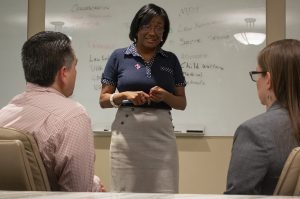Child Trafficking Study Yields Statewide Protocol, Reveals Major Voids in Services
By David Miller
March 10, 2021
With several book chapters and manuscripts on the horizon, the impact of the Juvenile Victims of Human Trafficking in Alabama Project will be reflected in a variety of ways, particularly in the connections formed with state agencies and community organizations, and the subsequent training and education provided by University of Alabama School of Social Work researchers.

Dr. Javonda Williams (center), principal investigator for the School of Social Work’s DOJ-funded anti-child trafficking project, led education and reporting protocol training for thousands of Alabamians.
Since the project began in early 2018, several thousand treatment providers, law enforcement officers and prosecutors, among other community members, have been trained in how to assess potential child trafficking situations, how to report those cases, and how to work with one another to improve outcomes for Alabama’s children.
Javonda Williams, associate dean for student services and principal investigator for the Department of Justice-funded project, said her team took advantage of every opportunity to inform and educate as many people as possible, from state summits to grass roots meetings, to more specific, targeted requests for training; for instance, Williams and her team provided training to a Tuscaloosa-based, district attorney-led rehabilitative program for people who are arrested for solicitation of prostitution.
“Wherever our team could get in, we did,” Williams said.
In addition to creating a recovery protocol throughout the state, researchers for the three-year, $1.35-million project also created a resource database and screening tool via its Bring Exploitation of Alabama Minors to a Stop (BEAMS) web site. Requests for trainings and partnerships can be made through the site, and a service provider database is a key component. Training materials and research literature on the site cover topics like “should prostitution be de-criminalized?” “when victims become offenders,” and “domestic minor sex trafficking.”
Christian Lim, project administrator for the grant, told Alabama Public Radio that the BEAMS database is “part of a culture change for law enforcement,” particularly in confirming if sex workers they’ve arrested were coerced.
While law enforcement agencies are beginning to advance their thinking of how sex work and human trafficking intersect, the aspect of victimization and the misperceptions of sex workers was a barrier that Williams and project researchers encountered often, even with service providers. Williams said that she and her team promoted a victim-centered approach for youth who have been trafficked, as there’s “no such thing as child prostitution.”
“People may see a sexually active or responsive teenage girl on the streets and think that’s where she wants to be,” Williams said. “For many of the providers we talked to, it was viewed more as a delinquency issue.
“So, creating these conversations among service providers, getting them all at the table, was a big deal for us. Getting the prosecutor at the same table as the children’s advocacy center was important. Connecting these dots was a big win for us. Creating the protocol, as a result, was huge – everyone knows what they’re supposed to do.”
 These conversations and capacity building revealed more than antiquated policies and misconceptions; Alabama’s dearth of resources and services to rehabilitate victims of child trafficking were a surprising, continual revelation, both in complexity and scale, Williams said.
These conversations and capacity building revealed more than antiquated policies and misconceptions; Alabama’s dearth of resources and services to rehabilitate victims of child trafficking were a surprising, continual revelation, both in complexity and scale, Williams said.
Housing was a significant, often unmet need. Williams recalls instances where rescued children in Alabama were relocated to rehabilitative centers or homes in other states, due to a shortage in-state.
“Working with the agencies and seeing those gaps in services in real-time was challenging,” Williams said. “We were getting calls from agencies, like ‘hey, I have a 14-year-old … where do I send them?’”
Williams also noted a shortage of education, counseling and medical services, especially dental care, for rescued children. Working through the frustration of limited services was a challenge for Williams, but also for the “hardworking agencies trying to get the job done,” she noted.
“Agencies were calling with boots on the ground – this wasn’t just a theoretical academic exercise,” Williams said. “I wanted to collect my data, do my presentations and create a statistical picture, but what I got was a real, up-close view of what it’s like to provide these services for children in Alabama.
“I learned that cost of recovery is unbelievable. The next steps are to think about the rehabilitative costs.”
